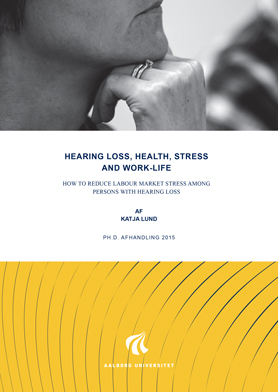PhD Thesis by Katja Lund: How to Reduce Labour Market Stress among Persons with Hearing Loss
The target group is persons with hearing loss who use aural communication rather than sign language in their daily communication. The study is based on a biopsychosocial stress understanding and a salutogenetic conviction, which means that different aspects and contexts in life are inextricably linked and that the totality of these contexts is essential to our ability to handle the stressors we encounter in our daily lives.
Method
To support this holistic understanding in identifying stressors and the ability to handle stressors among hearing-impaired employees, I have, in collaboration with PhD candidate at Aalborg University, Lisbeth Kappelgaard, developed the method Ecological Momentary Storytelling. The method is based on the triangulation of data where physical, psychological and social factors that can affect the experience of stress are measured. Physical factors are measured by observing the participants’ heart rate variability, while psychological and social factors are measured via a mobile phone that prompts participants to assess here-and-now experiences every wake hour. In addition there is a temporal factor as the method is applied over one week. Finally the data from the test-week is reflected on during a follow-up dialogue where discoveries can be integrated in order to help the participants gain awareness on everyday contexts that may promote or inhibit the development of stress. Six hard of hearing employees aged 50-64 years employed in various Danish companies completed a week of Ecological Momentary Storytelling in the period 2013 - 2014.
Results
Data from the reflective dialogues were analysed on the basis of Grounded Theory and various categories became clear through three layers of coding. The main categories, that give an impression of factors important to the development and management of stress, are:
- The experience of being able to maintain control in various communication situations and the ability to manage one’s energy level over a working day.
- The different contexts that may affect the individual’s ability to maintain control in various communication situations and to preserve energy during a working day. This can be noise level, number of people in the room and generally factors that can affect communication flow and energy level in a positive or negative direction.
- The narratives told about the individual, both by the individual himself as well as by the colleagues and management at work. These narratives define to a large extend the role and identity attached to the individual in a work context.
Data from the mobile entries in the test week were analysed and compared with the findings from the dialogues. This spurred further findings indicating that interaction with other people generally provides energy, as long as the individual does not experience a high level of noise and / or poor communication and listening conditions.
In order to handle the above factors it is necessary for each employee with hearing loss to become aware of how one is affected by different contexts in a specific moment, and the method supports this process. But it is also necessary that the responsibility for dealing with hearing loss in the workplace is shared with colleagues and management, so that the individual is not alone. The company management may use different strategies for dealing with this.
A dialogue tool was developed in this thesis, which combines survey results with the salutogenetiske theory of Sense of Coherence, in order to support professionals / managers / HR consultants in dealing with the prevention and the reduction of stress among hearing-impaired employees.
Finally, an inclusion model was constructed, which clarifies the risks and opportunities that may be associated with the choice of different strategic approaches in employment of employees with hearing loss. It is recommended that the company prepare a communication policy that not only takes into account the hearing loss, but also sees effective communication as being equal to team performance and bottom line outcome.







